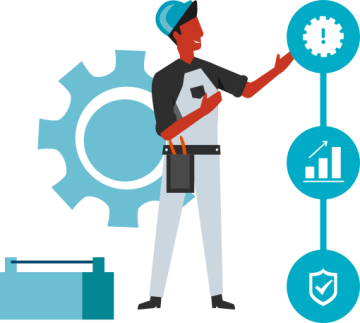In a maintenance department, a crisis can take various forms, but having a well-defined preventive maintenance plan can help prevent many issues before they escalate. From unexpected equipment breakdowns to costly production delays, as well as safety incidents that directly threaten staff and the work environment, these situations can arise due to mechanical failures, human errors, or even gaps in communication and data management.
Anticipating these problems before they become critical is essential to maintain smooth and secure operations. Acting quickly can also prevent a lot of damage, whether it’s material, financial, and/or human.
A fully functional CMMS must enable you to meet these challenges by improving responsiveness and planning necessary interventions well in advance.
Optimization of Real-Time Maintenance Operations
Proactive maintenance interventions start with constant monitoring of equipment condition, centralizing technical information for a swift response in case of failure, and planning and prioritizing emergency interventions. A maintenance software will help you improve these three critical aspects.
Continuous Monitoring and Early Anomaly Detection

This facilitates the transition from preventative to predictive maintenance. Anticipated maintenance needs, based on the actual condition of devices, have a significant impact on maintenance costs, equipment reliability, and lifespan.
Rapid Response Thanks to Information Centralization

CMMS centralizes all information related to equipment, interventions, spare parts, suppliers, contracts, and standards. It offers a comprehensive and updated overview, accessible at any time on any device. This greatly facilitates communication between internal teams and information sharing.
Planning and Prioritizing Emergency Interventions

This tool assists maintenance teams in effectively managing crises, by making better decisions, mobilizing appropriate resources, and complying with deadlines and standards.
Strengthening Internal and External Communication
Real-time Information Sharing with Teams
CMMS is key to disseminating essential information to maintenance teams, whether they’re in the field or the office. With a user-friendly interface and a mobile app, it provides access at all times to technical data sheets, historical records, and safety instructions required for the intervention. Technicians can log the details of their interventions, and managers can track their operations.
Improved Coordination with Suppliers and Subcontractors
By centralizing contract data, orders, deliveries, and billing, CMMS ensures optimized management of relationships with suppliers and subcontractors. It facilitates direct communication for the monitoring of interventions and orders, for better management of purchases, deadlines, and costs, while ensuring the quality of services.
This ability to improve coordination establishes mutual trust with external partners.
Implementing a Preventive Maintenance Strategy

CMMS allows for the scheduling and automation of maintenance operations—whether for regular upkeep or repair—to be carried out at regular intervals or based on specific criteria. It helps to define frequencies, durations, required resources, spare parts, instructions, and quality criteria for interventions. Additionally, it automatically generates work orders, purchase orders, and maintenance reports.
Thus, it greatly simplifies maintenance management, eliminating forgetfulness, errors, or delays while reducing the risk of breakdowns, improving equipment reliability, and extending their lifespan.
Client Case: How ORYX’s implementation of CMMS improved their management of maintenance interventions.
To date, we have issued 17,866 work orders. I am able to check which critical tasks have been carried out by country and by affiliated company, to see ongoing and past preventive and corrective actions, to see which contractor intervened as well as the associated costs. The scheduled maintenance tasks are also visible in the DimoMaint solution. This functionality is very useful because I now have a calendar; I am aware of the tasks that the maintenance technicians need to perform throughout the month, and I can anticipate the needs in terms of budgetary resources.
Key CMMS Features to Meet Maintenance Challenges
- Centralization of information: Centralizing technical data, maintenance histories, information on spare parts, and contract details allows for better decision-making.
- Planning and automating maintenance: CMMS assists in planning preventative and corrective maintenance based on collected data and insights generated by trend analysis. Automating recurrent tasks and creating work orders ensures that nothing is forgotten and that resources are optimized.
- Resource and inventory management: Effective tracking of spare parts inventories and purchasing management through CMMS reduces costs and lead times. This ensures that necessary parts are always on hand without overstocking.
- Analysis and reporting: Advanced analytics features allow for the generation of detailed reports on equipment performance, efficiency of interventions, and maintenance costs.
- User-friendly interface and mobile access: An intuitive user interface and a mobile app allow for easy and quick access to information for field technicians and managers, ensuring a faster response to emergencies.
Adopting a CMMS signifies a major evolution for maintenance departments looking to increase efficiency and mitigate risks. By centralizing data, improving communication, and anticipating maintenance needs, CMMS transforms maintenance interventions from reactive to proactive. Ultimately, CMMS doesn’t just prevent crises; it enables businesses to adapt and evolve in an increasingly complex and demanding industrial environment.




